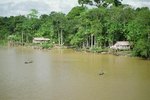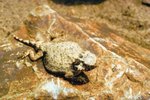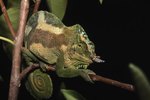
He is also commonly known as the giant horned lizard and the colima horned lizard. Scientifically speaking, he is referred to as Phrynosoma asio. He is the largest of horned lizard species. Like his horned cousins, this lizard squirts a bloody substance with a foul taste from his eyes as a defense mechanism against predators.
Physical Description
Long-spined horned lizards feature brown and gray colors on the top side with white or yellow on the under belly. They average eight inches in length. Their bodies widen in their middle section. Their tails are flat and rounded. Their bodies feature two rows of abdominal fringe upright scales along each side. Their heads feature horns above their eyes and on the back.
Diet
These lizards eat grasshoppers, flies, spiders, crickets, termites, beetles and ants - the last of which is the bulk of their daily intake. They are patient hunters of their prey. They seek out one insect at a time to capture and eat before setting their sights on another. When hunting ants or termites, the long spined horned lizard hangs out near the insect's trail and snags them one at a time as they travel. If a grasshopper is their prey of choice, these lizards wave their tail at the insect to create a distraction that diverts the insect's attention. Then the lizard can snatch the grasshopper.
Habitat
The long spined horned lizard makes its home in the semitropical and tropical areas of Mexico and Guatemala -- mostly in regions along the Pacific Ocean coast. However, they are found in other sections of both countries that feature warm and moist weather including the Gulf of Mexico coast. They like rocky hillsides, dry drainage areas in tropical deciduous forest and dry tropical areas covered with scrub brush.
Typical Activity
This lizard is most active in the mornings and late afternoon in an effort to avoid the hottest portion of the day. They prefer to be solitary rarely interacting with members of their own species aside from mating. This lizard is adept at blending in with its surroundings when sensing threat. He uses the earth-tone colors of his body as camouflage. If he is aware that he is being stalked by a predator, the long spined horned lizard becomes completely still until the danger has passed.
Use Of Water
He is able to survive the prolonged periods of drought that dominate his home region from November to April. When rain does fall, he uses his unique body shape to collect the moisture for his hydration. Via a technique called rain-harvesting, this lizard uses his rows of scales along the side of his tail and back to channel water from his body to his mouth.
Reproduction
These lizards mate in May and June. The males take the lead in initiating sexual activity by licking with their tongues, wagging their tails and bobbing their heads to alert willing females that they also are ready for action. A single act of copulation lasting anywhere from two to four minutes results in anywhere from ten to 25 or more young. Gestation of the fertilized eggs lasts 60 to 70 days with young hatching in the fall months between September and November.
References
Photo Credits
-
Hemera Technologies/AbleStock.com/Getty Images
Writer Bio
Amy M. Armstrong is a former community news journalist with more than 15 years of experience writing features and covering school districts. She has received more than 40 awards for excellence in journalism and photography. She holds a Bachelor of Arts in communications from Washington State University. Armstrong grew up on a dairy farm in western Washington and wrote agricultural news while in college.




